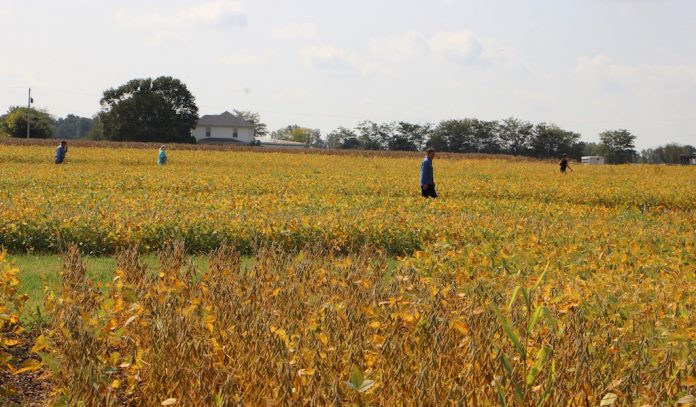
COLUMBUS — As weeds become more resistant to chemicals, herbicides become stronger to stay ahead of the battle.
Monsanto’s release of the herbicide dicamba, approved for use the first time this spring, was intended to be the strongest weed killer on the market.
But only dicamba-resistant soybean varieties from Monsanto — such as Xtend — are strong enough to resist the impacts of the herbicide.
Complaints
As late summer rolled around, farmers in the South and Midwest who didn’t use Xtend soybeans started reporting their fields were affected by drifting of the herbicide.
Thousands of complaints have been filed in Tennessee, Arkansas and Missouri, explained Mark Loux, Ohio State professor and Extension specialist in the area of weed management in field crops.
To date, there have been 25 official complaints to the Ohio Department Agriculture related to dicamba drift, Loux said in an interview at the Farm Science Review Sept. 20.
Loux said this smaller number of complaints is most likely due to neighbors not wanting to blame neighbors, and that Ohio growers didn’t use as much dicamba to see the same widespread damages experienced farther south and west.
In some cases, dealers declined to spray any of it post-emergence after the complaints began to roll in, he said. So what is actually to blame for the drift? Loux said there is no definitive answer.
Weather conditions
With most of Ohio experiencing a very wet spring, pre-emergent spraying of soybeans had to be delayed due to wet fields or even replanting. And when field conditions were suitable for sprayer traffic, farmers often faced high winds and inversions as they rushed to get the work done.
Not all of the drift issues were applicator error, explained Loux. “Most of what I saw was volatility and flooded fields” causing dicamba to drift or travel to neighboring, untreated fields, he said.
Volatility
Volatility was the biggest issue for dicamba drifting from field to field, explained Loux. Temperature affects volatilization, and there were no temperature restrictions on the use of dicamba, he said.
Inversion occurs when cold air close to the ground is trapped by a layer of warmer air, causing those fog- or mist-like layers you see in late spring or summer as temperatures start to rise. Dicamba particles can drift into those inversion layers and be carried from field to field.
Because some farmers were delayed in applying herbicides, the temperatures had began to rise, making it more likely for particles to become trapped in those inversion layers.
“There are guys who did everything right” and were still up against volatility, he said.
More research needed
Related: Herbicides alone cannot adequately manage herbicide-resistant weeds
Monsanto did not allow any university research to be conducted prior to its release of dicamba, making it hard for researchers to understand how the product can move.
“We need a set of weather conditions for use of dicamba,” said Loux. Spraying on a 70-degree day is better than an 80-degree day, but spraying soybeans post-emergence is where producers face more challenges in volatility.
“Maybe we need to have a post-emergence cut-off,” he said. Loux suggested using dicamba early season, and if it is needed late season, be conservative with it.
It is also important to know what’s around you, noting that orchards and vegetable operations, as well as non-resistant soybean varieties, can suffer major damages from dicamba drift.
“Producers shouldn’t have to buy Xtend beans just to avoid drift issues,” said Loux.
If researchers can get a better understanding of the volatility of the product, more recommendations can be made to avoid drift.
But, “if we have another year like this year, (dicamba) will be gone,” he said.










I have had the privilege of watching farms across the street for 30 years and know the farmer very well and that’s a privilege let me tell you. I am of course an outdoorsman but at 65 it’s getting hard to get around. One of my best attributes is in the field of observation and we will thank the military for that.
I blame herbicides for a whole lot of the present woes in my area. I wrote to ODNR years ago about the complete absence of gray and red foxes and it was gradual decline which started with the onset of no-till farming. They wrote back with basically chatter, but not one solitary thing has changed in my town since 1969, except the use of herbicides. When you see 100 acres go from green to brown over-night do not try and tell me this is harmless.
Snakes are rare as well as field mice which are 90% of its diet. The odd thing though this year is the complete rarity of seeing White Tails. I am not blaming herbicides yet on this but I think the past is catching up with us.
Hawks, Owl, are nearly gone and no, it’s not the Coyotes as I have seen one in two years. Herbicides must be discontinued and the consumer will pay more, but the chemical companies are making billions and I believe farmers must take charge on this as I know you are observing similar conditions.
This dicamba volitilizes and moves for days after application. Every acre of over 3000 acres of soybeans on my farm had dicamba damage. It filled the atmosphere and moved everywhere including in town and yards.